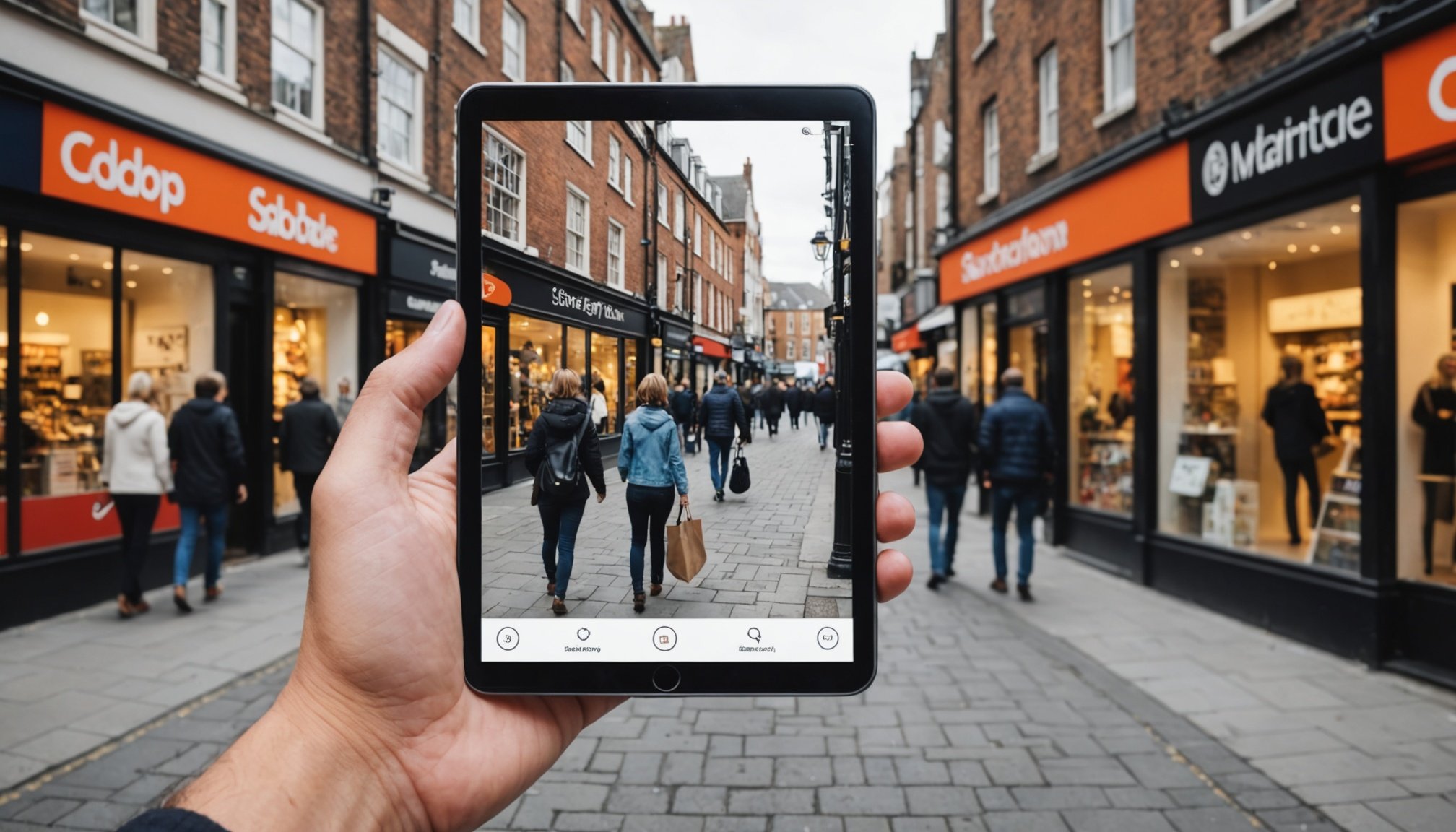Understanding Augmented Reality in Retail
Augmented Reality (AR) is a groundbreaking technology that overlays digital information onto the real world, enhancing the physical shopping experience. In the retail sector, it brings a revolutionary way to engage consumers by integrating virtual elements into real-world environments.
At its core, AR technology enhances customer interaction through virtual try-ons and interactive displays. Popular platforms like IKEA Place and Sephora Virtual Artist enable customers to visualise how products will look in their space or on themselves before purchase. This innovative use of technology in retail transforms how consumers make purchasing decisions, offering a seamless blend of reality and virtualisation.
In the same genre : Mastering the Art of Opening a Specialty Coffee Shop in the Countryside of the UK
The key benefits of using AR in retail are manifold. It increases customer engagement by making the shopping experience more immersive and personalised, thus improving decision-making and reducing return rates. Additionally, AR in retail advertising aids in creating impactful and memorable marketing campaigns, capturing consumer attention more effectively than traditional methods.
Furthermore, AR helps retailers collect valuable consumer insights through interactions, aiding in better understanding customer preferences and enhancing future strategies. As technology advances, AR’s role in the retail sector continues to grow, offering endless possibilities for innovation and customer satisfaction.
Additional reading : Creating an Effective Digital Literacy Curriculum for Seniors in the UK: A Step-by-Step Guide
Best Practices for Implementing AR Advertising
When it comes to AR Advertising Best Practices, creating engaging and interactive experiences is key to captivating consumers. By offering interactive elements, brands can hold consumer attention, making the ad experience memorable. This involves utilising technologies that allow users to interact with virtual components in real-time, enhancing the user’s overall experience.
Another critical aspect is ensuring seamless integration of AR within existing marketing strategies. Effective Strategies involve harmonising AR projects with brand messaging and campaigns. This consistency not only reinforces brand identity but also maximises the impact of AR initiatives. Businesses should consider AR not in isolation but as a complement to their overall marketing plan.
User experience and accessibility also play a pivotal role in AR implementation. Besides being technologically advanced, AR solutions must be user-friendly, accommodating diverse audiences. This includes ensuring that AR functionalities are easily accessible on various devices and platforms. The aim should be an inclusive design that does not alienate any potential users.
Achieving these objectives requires collaboration between creative and technical teams to create AR experiences that not only showcase technological prowess but also foster consumer engagement and brand loyalty. By prioritising these strategies, businesses can ensure their AR advertising efforts yield substantial results.
Creative Campaign Ideas for UK Retailers
Augmented Reality (AR) is revolutionising the way UK retailers engage their customers. By integrating AR into retail marketing innovation, brands can elevate their customer experience to new heights. Let’s explore how AR can be harnessed effectively.
Case Study: Successful AR Campaigns in the UK
A prominent example is a cosmetic brand that utilises AR to let customers try on makeup virtually, reducing the return rate and enhancing customer satisfaction. This innovative use of AR enhances convenience, providing a seamless shopping experience that encourages purchase decisions.
Unique AR Concept Ideas for Retail Brands
Retail brands can create AR experiences that allow customers to design their own products. For example, incorporating an interactive AR app where customers can customise trainers, ensuring an exciting and personalised shopping journey. This fosters creativity and deepens brand connection.
Seasonal and Event-Based AR Campaigns
Utilising AR for seasonal promotions is a game-changer. Retailers can use AR to overlay limited-time offers on products when customers scan them with their phones, creating a sense of urgency and exclusivity. During local festivals, brands might introduce AR scavenger hunts, encouraging participation while subtly building brand loyalty. Such innovative approaches not only engage customers but also position brands as leaders in retail marketing innovation.
Targeting and Engaging the Right Audience
To effectively deploy AR campaigns in retail, identifying target demographics is crucial. Begin by evaluating existing customer data, leveraging it to personalise AR experiences. By understanding age, purchasing habits, and preferred channels, retailers can craft tailored interactions that resonate deeply with their audience.
Utilising customer data is key to successful Audience Engagement. Harness information from previous purchases and interactions to create bespoke AR experiences. This not only captivates users but also transforms casual browsers into loyal buyers by offering exclusive content or promotions.
Consumer Targeting in Retail involves strategic approaches to drive traffic and interaction. Implementing AR advertising in storefronts and digital platforms can significantly enhance visibility. For instance:
- Augmented reality provides virtual try-ons or interactive tutorials.
- Special promotions activated through AR scans can boost in-store visits.
Such strategies not only amplify visibility but also enrich the shopping journey. By addressing these touchpoints, retailers can redefine their approach to engaging with consumers, making their offerings more appealing.
Adapting these techniques ensures that the right consumers are reached, enhancing their overall shopping experience and fostering brand loyalty. Focusing on these elements guarantees a seamless blend of technology and customer engagement.
Measuring the Success of AR Advertising Campaigns
In today’s rapidly evolving digital landscape, businesses are keen to measure the success of their AR advertising campaigns. The first step towards understanding effectiveness involves identifying key performance indicators (KPIs). Common KPIs include engagement rate, conversion rate, and dwell time. These metrics help gauge how well the campaign resonates with the target audience.
Using advanced analytics tools is essential for tracking consumer interaction. Such tools can provide insights into user behaviour, allowing businesses to determine precisely how and when users engage with their AR content. With this data, companies can optimise their campaigns for better results.
To truly understand the potential of AR advertising, consider reviewing successful case studies. For instance, some businesses have reported a significant increase in engagement, with users spending more time interacting with AR elements than with traditional ad formats. This demonstrates AR’s ability to create a memorable and immersive brand experience.
In summary, measuring AR success requires a combination of well-defined KPIs and sophisticated analytics tools. By doing so, businesses can fine-tune their marketing strategies and maximise the effectiveness of their AR campaigns.
Legal Considerations and Challenges in AR Advertising
Augmented Reality (AR) advertising brings innovative opportunities and unique legal issues. One critical aspect is understanding data privacy regulations. Compliance is essential as AR integrates with user data, transforming how retailers engage consumers. Yet, protecting user privacy while personalising experiences poses significant challenges.
Regulations such as GDPR in Europe and CCPA in California mandate strict data handling protocols. Businesses must ensure AR applications respect user consent and data protection rights. Failing to comply can lead to hefty fines and damage to brand reputation.
AR technology implementation also presents technical and ethical hurdles. Retail challenges include maintaining consumer trust amidst increasing scrutiny and safeguarding sensitive information. It’s imperative to educate stakeholders on the nuances of AR marketing and technology.
Developing strategies to overcome these obstacles involves investing in robust cybersecurity measures, staff training, and staying informed about evolving legal landscapes. Proactively addressing privacy concerns enhances consumer confidence and positions AR campaigns for success.
Key strategies include:
- Ensuring transparency with data usage through clear communication.
- Regularly updating systems to reflect current legal standards.
- Collaborating with legal experts to navigate complex regulations.
By anticipating and managing these legal challenges, businesses can harness AR advertising’s full potential.
Integrating AR with Other Marketing Channels
Integrating Augmented Reality (AR) into your integrated marketing strategies is rapidly becoming essential for harnessing digital mediums’ full potential. One of the best practices involves merging AR with social media and digital platforms to create immersive experiences. For example, brands can utilise AR filters on apps like Instagram and Snapchat, allowing users to visually interact with their products in a personal and engaging way.
Enhancing influencer marketing campaigns with AR elements is another savvy strategy. Imagine influencers using AR to showcase products in interactive formats, such as trying on virtual clothing or testing makeup looks. This not only boosts engagement but also provides a more authentic demonstration, driving higher consumer trust.
When creating cohesive brand experiences, leveraging cross-channel AR is crucial. Brands can seamlessly blend AR with existing content on various platforms, ensuring consistent messaging and visual aesthetics. This unified approach encourages consumers to engage with the brand through multiple touchpoints, creating a more memorable and impactful interaction.
Ultimately, cross-channel AR highlights the importance of developing a coherent strategy where each marketing element complements the others. By doing so, brands can enhance customer interactions and establish a strong omnichannel presence in the competitive digital landscape.







